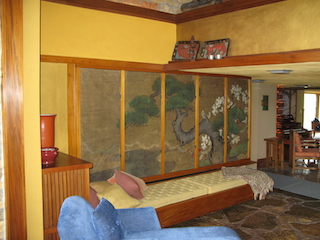Client News: Frank Lloyd Wright Foundation uses Tru Vue Optium to conserve Japanese screens and Chinese paintings at Taliesin
The Frank Lloyd Wright Foundation has begun phased conservation of the Japanese screens and Chinese panels at Taliesin, the National Historic Landmark that was Frank Lloyd Wright’s Spring Green, Wisconsin, home and architectural studio. A total of eight multi-panel screens and panels will be conserved, room-by-room. Instrumental to the long-term display in their original locations will be their protection using Tru Vue® Optium® Acrylic Glazing, a shatter- and abrasion-resistant, anti-static, anti-reflective material that filters up to 99 percent of damaging UV light. The first of these pieces to be reinstalled is an impressive Japanese painting in the style of the 17th century artist Kano Yasunobu, which will return to the Blue Loggia at Taliesin in May 2015, prior to the celebration of Wright’s birthday on June 8.
Margo Stipe, the Frank Lloyd Wright Foundation’s curator and registrar of collections, said, “The protection offered by Tru Vue Optium glazing will allow the original Japanese screens and Chinese paintings to again be safely displayed as Wright intended, serving as important interior details of the home. The museum-quality, non-reflective glazing provides the perfect solution for protecting these pieces while on display within the unique and challenging environment of Taliesin.”
The Japanese screens and Chinese panels’ conservation project is led by the collections and preservation staff of the Frank Lloyd Wright Foundation, Taliesin Preservation, Inc. (TPI) and T.K. McClintock of Studio TKM Conservation of Fine Art and Historic Works on Paper.
Surveys of the Japanese and Chinese paintings begun some years ago showed that they were becoming markedly compromised in condition, appearance and potential longevity, necessitating the removal of some of them to storage. “By protecting the paintings from exposure and visitor traffic, Tru Vue Optium Acrylic Glazing will allow for the paintings to be displayed in their original locations and configurations and for the appearance of the interior to be more authentic,” stated T.K. McClintock of STUDIO TKM, which is donating the services to conserve the paintings in celebration of their long-standing relationship with the Frank Lloyd Wright Foundation.
Tru Vue vice president of new business development, Patti Dumbaugh, explained, “These decorative elements are a key historic feature of Taliesin. When the conservation is complete, visitors, students and scholars can admire and study the pieces as they were intended to be enjoyed and experienced. The anti-reflective coating of Tru Vue Optium erases the boundary between the artwork and the viewer. Optium allows the screens to be presented without distraction of glare and with an intimacy suited to Wright’s home.
The influence of Japanese art on the drawings, architecture and decorative arts of Frank Lloyd Wright is well documented. Stipe said, “While Wright included Japanese screens and other works of Asian art in a number of his most remarkable residential works, it is within Taliesin that Japanese and Chinese paintings were most abundant and most carefully integrated.”
Frank Lloyd Wright adapted a strategy of accommodation when the paintings he wished to mount on the walls could not be maintained in their original formats. Panels of folding screens that became separated from their original format were displayed with decorative strips between them, or removed from the panels altogether, and mounted onto individual wooden panels. Throughout Taliesin, these panels and the paintings that remained as folding screens were secured to the walls and visually integrated by the use of moldings with the same profile and of the same material that were used elsewhere in the room.
Many of the screens were rotated among different locations, while others remained in locations where the dimensions were configured specifically for them. Of the 48 Japanese and Chinese paintings that remain from a lifetime of collecting, 10 works are currently on display in the Living Room, Loggia, Blue Loggia, Guest Room, Olgivanna Wright’s and Frank Lloyd Wright’s individual bedrooms and the Studio.
Jim Erickson, Taliesin estate manager, noted, “The importance of these paintings to the understanding of Taliesin, and the influence on and artistic vision of the architect, has always been appreciated by members of the Taliesin community and by scholars of both Frank Lloyd Wright and Japanese art who were aware of the collection. Frank Lloyd Wright was a critical link between the first generation of collector scholars and later generations of amateurs and connoisseurs of Japanese paintings and prints.”
The Frank Lloyd Wright Foundation and TPI are committed to the preservation of Taliesin. Stipe added, “These Asian art pieces contribute immeasurably to what Frank Lloyd Wright termed the ‘eye music’ of Taliesin. Tru Vue’s support of this project makes Wright’s vision for the decorative appeal of Taliesin live on in harmony to space, time and integrity of the site.”
About Tru Vue
Tru Vue is a longstanding corporate supporter of the arts and preventive conservation education, partnering with art organizations worldwide. Tru Vue manufactures high-performance glazing products for the custom picture frame and museum markets. Tru Vue is a leader in both UV protection, as well as anti-reflective and specialty glazing products for these markets. The company is located in McCook, Illinois, and in Faribault, Minnesota, and is part of Apogee Enterprises, Inc. For more information on Tru Vue and its collection of high-performance glass and acrylic glazing products, please visit http://www.tru-vue.com.
###
Filed under: CLIENT NEWS, Projects, Tru Vue

